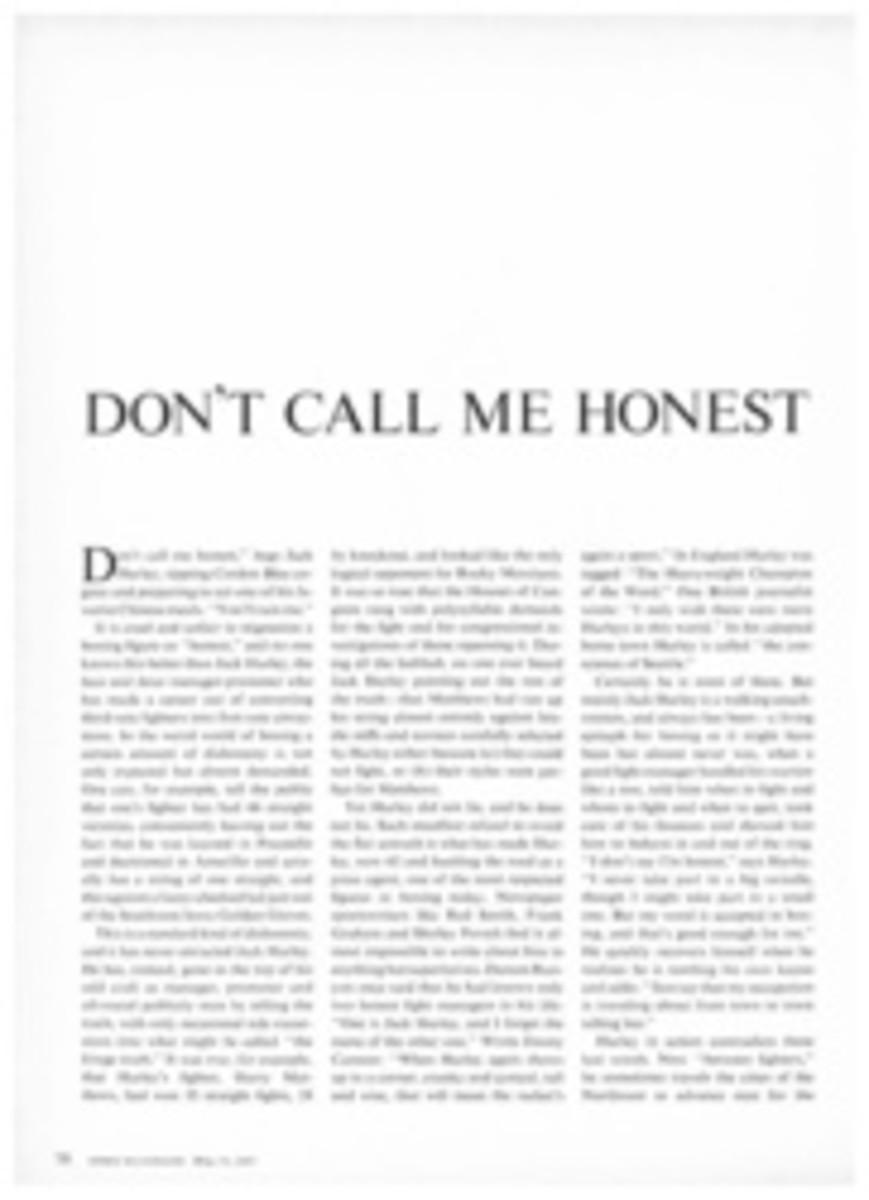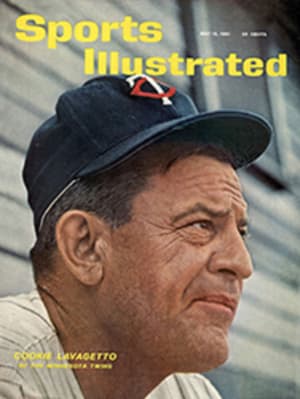
Bob and his marvelous monster
Into the calm, chill waters of Saginaw Bay, Mich. this week will be launched one of the most powerful and impractical speedboats ever built. Driven by an F-84 jet fighter engine, its bright, white hull (above) combines the unlovely shape of a lobster with the wallowing weight of a walrus. There is a fair chance that the freakish craft, to be christened Miss Stars and Stripes II, will founder in its own bow wave the first time it hits 20 mph, and a good chance that at higher speeds it won't stay in the water at all, but will fly—briefly. If none of these misfortunes overtakes it, Miss Stars and Stripes II, however, may well achieve the dual purpose for which she was built: breaking the world water-speed record of 260.35 mph held by Donald Campbell of England and satisfying the long-thwarted competitive ambition of its owner, Robert B. Evans of Detroit.
Robert Beverley Evans ("with an ey in Beverley, please; it is often misspelled") is an intriguing new figure in a sport that attracts intriguing figures. Fifty-five years old, he has a head full of reddish hair, a face with a thousand freckles, a quick, fresh smile and eyes as cool and blue as Lake Michigan. He has made millions of dollars—as did his father before him—and his personality is no more modest than his means.
He considers himself, with some justification, an ingenious inventor. "I must have had a thousand ideas of ways to do things better," he says. "They just come to me. One hit me the other day like a ton of bricks. I forget it now. But I guess I hold 15 to 20 actual patents—no, if there's one thing I can't stand it is an overstatement. Let's say 10 to 15 patents." Among them are a fishing lure that snaps concealed hooks into the outside of a fish after it bites and a boat so unsinkable that "you could get lost in the middle of Lake Superior with a hole in the bottom and you might starve, but you won't drown."
He made his money, however, not with inventions, but in the world of business and finance. Starting with a sandwich-and-raccoon-coat concession at the University of Michigan—"Father thought a rich man's son should be poor and gave me no money"—he now owns three companies outright. "I enjoy taking sick companies and making them well," he says. "It is a pleasure to see the lines of worry vanish from the employees' faces." He is also vice-president of the Evans Products Company, a $100-million-a-year plywood-products firm which his father, Colonel E. S. Evans, founded in 1915.
It was the colonel, in fact, who set the first and only world speed record held by the Evans family to date. In 1926 he went around the world a la Phileas Fogg—by steamship, ricksha, airplane, etc.—in 28 days 14 hours and 36 minutes, beating the old record by a week. He returned to denounce the American airline industry as woefully behind the times, and to warn: "Russia is in the hands of visionaries. That country is worthy of American study."
Son Robert has done his best to follow in the astute and adventurous tradition of the colonel. "I was lucky, for the good Lord imbued me with no sense of fear," Evans says. And fearlessly, one presumes, he took up gliding and speed-boating, nearly killing himself at each. "I have always needed an exciting sporting sideline," he says. "You may say that I am not a vegetable."
He learned his gliding in Switzerland in 1929 and came back to be the self-styled "first glider pilot in the U.S." (The fact that one John Joseph Montgomery was gliding in California 45 years before abashed Evans not at all.)
Once he was almost killed when his glider crashed into an oak tree in the Blue Ridge Mountains. Later he nearly drowned crash-landing into a bay on Cape Cod. And finally he almost died of humiliation the day old Henry Ford arranged for him to give a demonstration of gliding at a Detroit airport. At the take-off, he sheared the wings off the glider, which collapsed in a heap, leaving Evans sitting in a pile of splinters and nails, like a Wright brother gone wrong.
Turning to speedboats in 1932, Evans got the idea of attaching small, winglike appendages below the water line of a Chris-Craft he owned. He was delighted when the boat's hull lifted clear of the surface and sped down the Detroit River on its steel water wings. Characteristically, Evans assumed he had discovered the hydrofoil, only to learn Alexander Graham Bell was among those who had beaten him to it. "The only thing new was my enthusiasm," he recalls.
In 1936, still fired with enthusiasm, he bolted a set of hydrofoils onto a cigar-shaped craft named Miss US III and set out to break the old water-speed record of 124 mph held by his Detroit neighbor, Gar Wood. He almost made it, too.
"Unofficially I broke the record several times," Evans says. "But I never could get the boat ready for an official try."
And, of course, he almost got killed. Going 90 mph in a test run over a turbulent stretch of the Detroit River, he was suddenly thrown out of the boat, the force of his impact with the water ripping off all his clothes. He bobbed to the surface, safe, shocked and stark naked.
Shortly thereafter he retired from speedboating—but not because of either the danger or the embarrassment. "That's an expensive sport," says Evans, and "when Mr. Roosevelt decided a man could only keep 10% of what he earned in business I gave it up."
Three years ago, after 21 years of relatively sedentary diversions such as golf, fishing and skin-diving, Evans came out of retirement. "It dawned on me there was no trophy for the death-defying man who sets the world record for speed on water," Evans said. "I got a great idea for a trophy. You'll love it when you see it. It is so different. I wanted something international and symbolic, and the world is so trite. On trophies, I mean. That's when I thought of the U.N. building."
The trophy is a two-foot silver scale model of the U.N. building, with miniatures of record-breaking boats around its base. "I named it the Robert Beverley Evans Trophy," said Evans. "I thought of calling it the Robert Evans trophy, but there are a lot of Robert Evanses in the world."
In the summer of 1958 Evans took his trophy to London and presented it to Donald Campbell. "I told Donald that within three years I'd be coming to take it back." To remind himself, Evans had an exact copy of the trophy made for his office and another placed in the lobby of the Detroit Yacht Club.
Within a year he tried to break Campbell's record with a propeller-driven hydroplane named Miss Stars and Stripes I. "That boat couldn't get out of its own way," he said. "Its top speed was 90 mph."
Last summer Evans decided to build a jet boat and went to see Les Staudacher, the celebrated manufacturer of church pews and Gold Cup-winning hydroplanes (SI, April 23, 1956). Staudacher had already constructed one jet boat in which he narrowly escaped death when he ran aground at 150 mph. But Staudacher was willing and anxious to design and drive another one.
"We signed a contract," said Evans. "Alcoa is putting up the aluminum, but I am paying for everything else myself. No company or publicity angle is involved. It is a true sporting venture with me, and the cost is coming out of my hide. I told Les, 'Les,' I said, 'this is my party; stay out of the pictures.' " Les liked the deal and has tried to stay out of the pictures.
The result of the Evans-Staudacher teamwork is what Evans calls "my fascinating monster." The design of Miss Stars and Stripes is strikingly similar to Campbell's Bluebird but was not arrived at until 30 test models showed this to be the best shape. Basically she is a three-point hydroplane, built to skim over the water on three small planing surfaces, one at the stern and one on each of her protruding sponsons. Her jet engine (worth $47,000 new, but costing $240 at a government-surplus sale) develops 5,800 pounds of thrust at 8,000 rpms. "It has enough power," says Staudacher, "to go straight up."
"Hydrodynamically," Staudacher says, "you'll never see a worse boat. Its forward motion may swamp it at 20 mph. Our models indicate it will just, by the narrowest margin, get up into the planing position. We don't have much margin for error," he admits, "and we don't know what is going to happen after 100 mph. Models don't show you that."
Last week, just before the launching, Les Staudacher was warming up his nerves and reflexes for the record try by driving a Gold Cup hydroplane at 150 mph. And Bob Evans had his lawyers arguing with his insurance men over whether he himself could drive his "fascinating monster." His life is insured for $1 million, and he sees no reason why he shouldn't drive his boat. The insurance men, however, can see a million good reasons why he shouldn't.
Besides getting the world record, Evans also wants to start some rousing international water-speed competition. "This boat has got to break Campbell's record," he said. "We won't quit until it does. If we only beat Campbell by one mile an hour he'll come right back at us and that's what I'm looking for. This could become a classic competition, like the America's Cup. Everyone likes a friendly race, especially an international one. It stirs pride and patriotism. We are ready."
PHOTO
ROBERT EVANS BEAMS PROUDLY FROM COCKPIT OF HIS NEARLY COMPLETED CRAFT
PHOTO
ROBERT BEVERLEY EVANS TROPHY is given to Donald Campbell (left) by Mr. and Mrs. Robert Beverley Evans.

